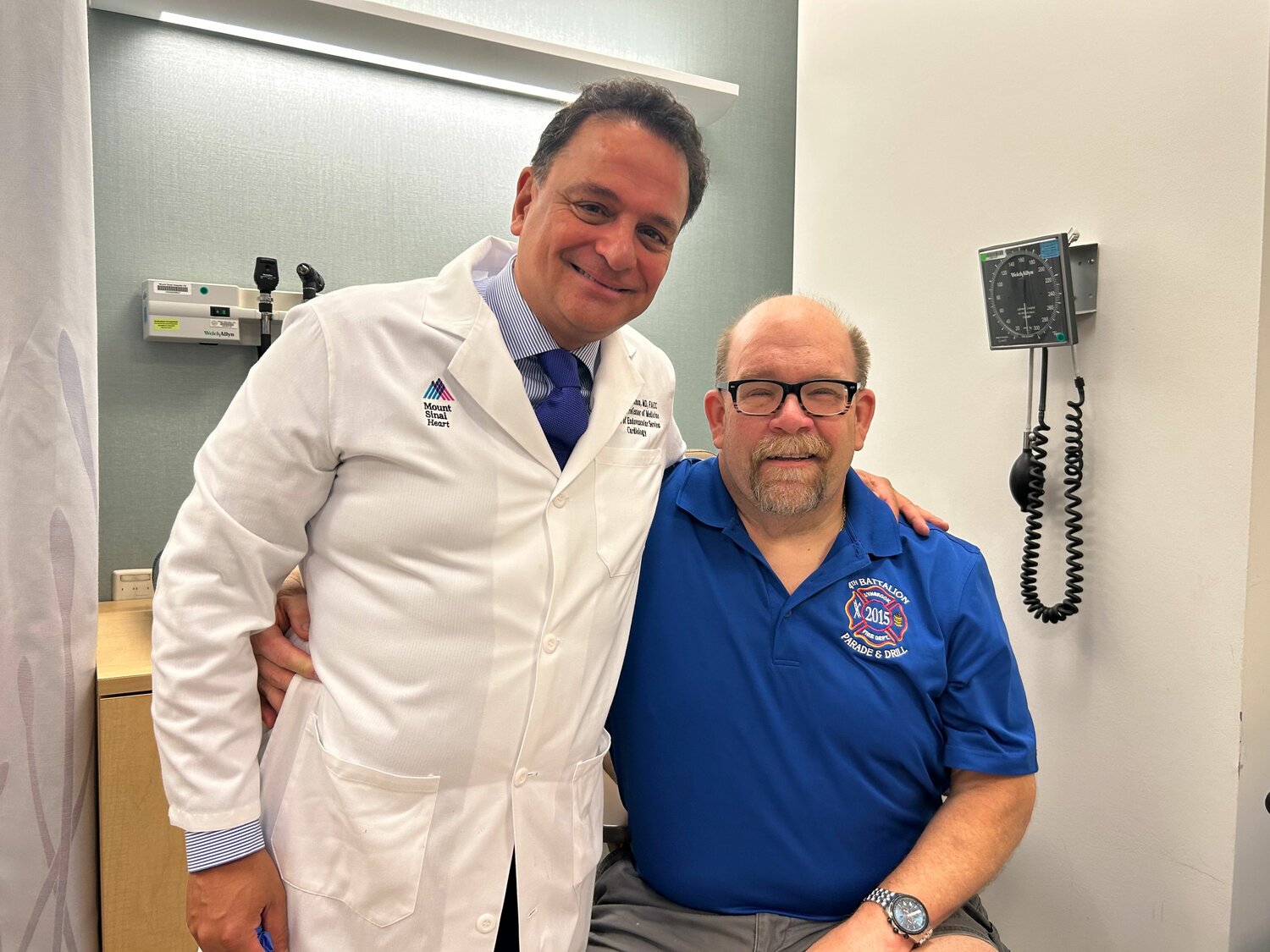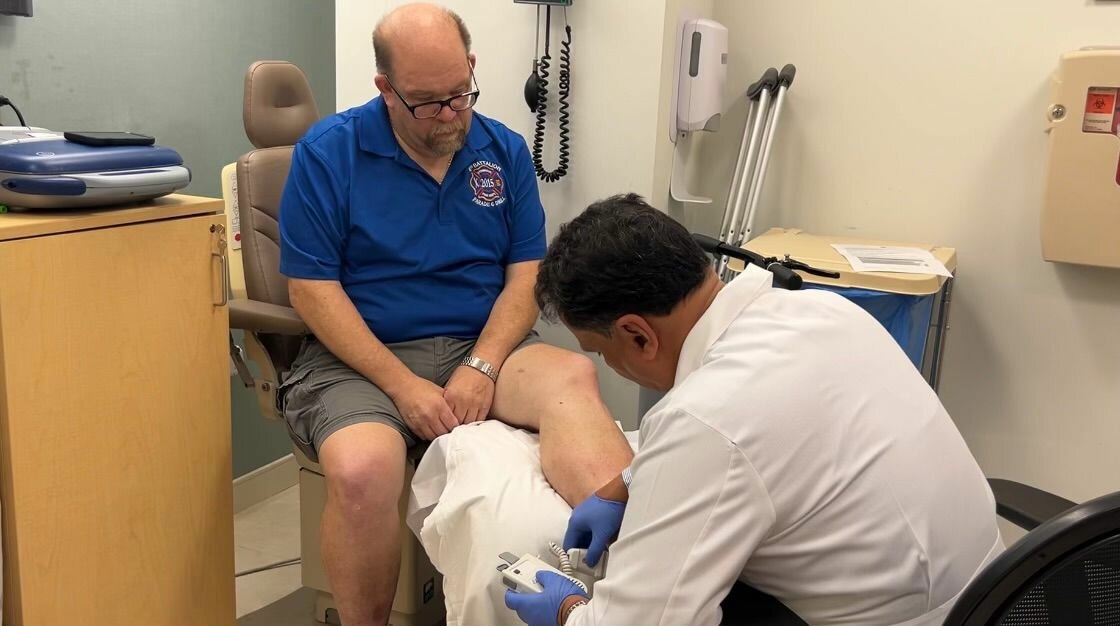Tuesday, June 18, 2024
Lynbrook man narrowly avoids losing both legs to artery disease

A 59-year-old Lynbrook volunteer firefighter will be able to continue to save lives and property after becoming the first person in the United States to receive a new, life-saving surgery.
Patrick Curran, a diabetic, developed peripheral artery disease about five years ago, which causes the arteries in the leg to get narrow and restrict blood flow. There are limited solutions for people with severe forms of this condition, and doctors told him that he needed both legs amputated, as he was at extremely high risk of heart attack and stroke.
However, the FDA recently approved a new device called Esprit BTK System, which restored blood flow in both of Curran’s legs.
“The ulcer that I have on my foot is healing, which means that the blood flow is getting there and healing it,” Curran said.
People like Curran who live with this condition, experience extreme pain, open wounds that do not heal and, in some cases, may have to resort to amputation. Over a five-year period, extreme forms of this disease have a lower survival rate than breast, colorectal and prostate cancer combined.
Curran has been in excruciating pain for years. His peripheral artery disease caused debilitating ulcers on his legs and extreme foot swelling. He had had several minimally invasive procedures to open the arteries and get his blood flowing again, but those were no longer working, and doctors told him the only option is to amputate his legs.
Curran received hyperbaric oxygen therapy where oxygen would be pushed directly into his open wounds. This helped heal the ulcers in his feet. However, within months of receiving this treatment, the ulcers started to come back.
Curran was then recommended by Dr. Toufic Safa to meet with Dr. Prakash Krishnan at Mount Sinai. Safa explained that he might have new procedures and tools that he could use to get the blood flowing again.
“He opened up the artery in my leg and got the blood flowing,” Curran said. “I went in for my follow up and he asked if the wound is closed and I said no not yet. I’ve been up on it, walking. And he goes, ‘I’m a little disappointed, as I thought it would be closed.’”
Krishnan explained to Curran that he needed to stay off his feet. However, Curran, being a volunteer firefighter and enjoys an active lifestyle, said that he cannot lie around and wait for it to close. This is what triggered an idea in Curran’s head that changed the course of his condition forever.
“I said to Dr. Krishnan, ‘Can I ask you a question? How come you haven’t put a stent in?”’ Curran said.
Curran has 13 stents in his heart, and he mentioned to Krishnan that it helps keep the valves open.
“He looks at me and he goes, ‘Would you be willing to be the first person in North America to be treated with this new FDA-approved device?’” Curran recalled. “He said, ‘You fit the profile.’”
Krishnan told Curran about the new FDA approved device, which is the first-of-its kind stent that dissolves into the leg artery over time. It opens the blockage, delivers medication over the course of several years, and eventually dissolves after a few years.
Krishnan explained that an ordinary stent can cause re-blockage after the drug is implemented into the artery. This is why he did not recommend a stent procedure. However, this new FDA approved device is dissolvable and contains a drug that prevents the risk of scar tissue from forming.
“Because diabetes is something that is not curable, we know that we are going to be faced with future challenges so with a regular stent, the next time I would need to go into his artery, I would need to deal with that metal piece inside the vessel wall,” Krishnan said. “But now with the scaffold, if I do have to go back in, the scaffold is completely gone, and I have nothing to worry about except treating the artery again.”
Curran said that Krishnan told him that this procedure would not only help him, but it would help everybody else in the country suffering from this disease. Curran immediately agreed to this procedure, as it will now give him and others an option to not have his legs amputated.
Curran was awake during the angiogram procedure. Krishnan said that he went in through the femoral artery through Curran’s groin, and put a small tube in, which cleaned the artery. Then after, the dissolvable stent was deployed through the tube.
Curran said that his doctors, using a doppler, already see immediate improvement in his blood flow. Curran now does not have to worry about having a sudden cardiac event and will keep his limbs.
“Dr. Krishnan said, ‘I could feel your pulses through the ace bandage on your foot.’ We couldn’t before.”
Curran recommends anyone with this disease to get this procedure done. He noted that this is a “big breakthrough” and any surgery is risky no matter what, but the outcome outweighs the risks.
“It’s phenomenal,” Curran said. “For the last five summers, I wasn’t able to enjoy my summer, as my feet would always give me a problem around the same time in July, and I hope to have a great summer. It’s very promising.”
HELP SUPPORT LOCAL JOURNALISM
The worldwide pandemic has threatened many of the businesses you rely on every day, but don’t let it take away your source for local news. Now more than ever, we need your help to ensure nothing but the best in hyperlocal community journalism comes straight to you. Consider supporting the Herald with a small donation. It can be a one-time, or a monthly contribution, to help ensure we’re here through this crisis. To donate or for more information, click here.
Sponsored content
Other items that may interest you









